Methi, commonly known as fenugreek, is well-known for its therapeutic properties. Fenugreek is used and consumed in different ways, including sprouts, microgreens, leafy vegetables, spices, dried herbs, and green manure. Both seeds and leaves of this plant are edible.
Small, firm, and oval-shaped fenugreek seeds are frequently used in Indian cuisine, and the plant’s tiny, light-green leaves are one of the primary components of curry.
The flavor of fenugreek seeds is hot and curry-like. Fenugreek loses its bitter and potent flavor when cultivated as a microgreen and develops a softer, sweeter flavor. It grows quickly, is inexpensive, and has a pleasant odor [1].
If Like to know more about microgreens, check these articles:
<<What Are Microgreens >> and <<Microgreens Benefits for Skin>>
Fenugreek History
Methi is an annual plant that belongs to the Fabaceae family. Fenugreek has been used since at least six thousand years ago. Fenugreek was considered a medicinal drug used by the Ancient Egyptians. They thought fenugreek could heal wounds and cause childbirth. They employed it in mummification as well. Hippocrates, a
Greek physician, employed it as a calming herb. Fenugreek was utilized as a treatment for illnesses by other ancient Greeks. It was also utilized by the ancient Romans to cure digestive and respiratory problems as well as fevers.
India currently produces the most fenugreek globally, followed by Nepal, Pakistan, Bangladesh, the Mediterranean, and Argentina. Fenugreek’s leaves are used as a herb, while the seeds are used as a spice. The tiny seeds have a yellowish brown color, a taste that leans toward bitterness, and a strong scent [2].
Fenugreek microgreens overview
| Family | Fabaceae |
| Nutrition | Vitamin A, B, C calcium, protein, copper, potassium, manganese and magnesium |
| Average days to germinate | 2 to 3 days |
| Average days to harvest (after germination) | 12 to 16 days |
| Difficulty | Easy |
Nutritional facts of methi microgreen
Fenugreek microgreens have various essential vitamins and nutrients including iron, vitamin C, vitamin A, vitamin B, calcium, protein, copper, potassium, manganese, magnesium, and fibers.
Due to Fenugreek superior therapeutic properties, it has made a distinct presence among plants. It contains various phytochemical compounds, including tannins, phenols, alkaloids, and flavonoids, which work together to give it its antioxidant, antidiabetic, hypocholesterolemia, and anti-carcinogenic properties. This plant is also used to treat various diseases and illnesses naturally. [3, 4].
Fenugreek microgreens nine days after planting
fenugreek microgreens health benefits
Fenugreek is used as a natural medicine by many cultures worldwide. However, no solid scientific evidence supports its medical applications, and the FDA has not yet commented on its efficacy.
Fenugreek is occasionally taken orally by people with diabetes to treat excessive cholesterol, menstruation cramps in women, and other health issues. Some of the fenugreek’s most important health benefits are as below [ 5, 6, 7].
Breastfeeding Mothers
Methi seeds can sometimes help breastfeeding mothers produce more milk. According to one study, breastfeeding mothers who drank fenugreek tea produced more milk, which helped their newborns gain weight. According to a different study, mothers who drank the tea were able to make twice as much milk as mothers who did not.
An increase in perspiration is one of methi microgreens’ adverse effects (sweating). Fenugreek’s impact on the sweat glands is assumed to be related to its capacity to stimulate milk production.
Blood Sugar Levels
According to a few clinical studies, people with diabetes may benefit when fenugreek powder is added to hot water or bread recipes. In some studies, people with diabetes who took one gram of fenugreek daily experienced reduced blood sugar levels and a more significant insulin response.
Menstrual Cramps
According to some research, fenugreek seed pills or tea made from the seeds may be able to lessen or cut the length of menstrual pain, such as cramps. By taking these pills, the number of extra painkillers women required during their menstruation may subsequently decrease.
Fenugreek seeds germination
Sexual Performance in Men
A study conducted in Australia discovered an intriguing connection between fenugreek extract and male testosterone levels. The males who had been taking fenugreek extract for six weeks said their libido (sex drive) and the sexual performance had improved.
Cholesterol Reduction
The saponins in fenugreek microgreens aid in lessening the body’s absorption of cholesterol from fatty diets. According to some research, saponins may also help the body produce less cholesterol overall, particularly LDL or bad cholesterol.
Cancer prevention
According to studies, fenugreek fibers may help prevent some cancers. For instance, fenugreek contains estrogenic properties and may be an alternative to hormone replacement therapy, according to research from the Rajiv Gandhi Center for Biotechnology in Thiruvananthapuram (HRT).
How to grow fenugreek microgreens
Growing your own organic methi microgreens at home is a terrific way to switch up the flavors in your kitchen and add extra fresh greens to your meals.
Fenugreek’s seed takes three to five days to germinate. You can harvest them almost two weeks after planting them. The procedure of growing fenugreek microgreens is almost similar to other microgreens. Read the <<Growing Microgreens >> article to learn more about the general method for growing microgreens.
fenugreek blossom – source: Arizona Herb Association
methi microgreens Growing Tips
Growing tips
- You do not need to soak fenugreek microgreen seeds.
- Since fenugreek does not need a lot of areas to grow, there’s no need to space your seeds evenly. Densely distribute the seeds over your growing medium.
- After you have planted your seeds, water them frequently. Since they need moist soil, fenugreek is often found in rainy regions.
- Microgreens can be watered from the bottom by putting the growing tray in a bigger, non-porous tray filled with water. After the medium has absorbed the required amount of moisture, remove the excess water.
- Once your plants have begun to sprout, relocate your crop to an area with sufficient lighting (near a sunny window or under a grow light).
- Microgreens may need 6 – 8 hours of sunlight or 12-16 hours of artificial light produced by grow lights.
Fenugreek microgreen seeds
Harvesting Tips
- You can harvest fenugreek microgreens when they reach 3 to 5 inches.
- Cut the methi microgreens close to the soil to highlight the brilliant stem.
Washing Tips
- If you did not cover the seeds with soil, you do not need to wash them.
Storing tips
- For the optimum flavor, vitamin content, and freshness, you should consume your microgreens as soon as possible after harvesting them.
- Microgreens may typically be kept in the crisper drawer of your refrigerator in a mesh bag for up to 3 days. They may start to lose nutrition and freshness after three days.
Fenugreek sprouts with seed hulls
How to eat Fenugreek microgreens
Fenugreek microgreens are frequently used in Indian cuisine and can be either fresh or dried. A small number of dried fenugreek leaves will give the ideal fragrant touch to a curry or dal [8 , 9].
Here are some delicious fenugreek microgreens recipes:
1) Breakfast Smoothie
Ingredients
- 1 or 2 cups fenugreek microgreens
- 1 banana
- 1 cup coconut milk
- 1/4 cup rolled oats
- 1 handful of fresh mint
- 1 tsp cinnamon
instruction
Add a mint sprig on top after blending ingredients to the desired smoothness!
2) Healthy Hummus and Veggie Sandwich
Ingredients
- 1 cup fenugreek microgreen
- 2 slices of sprouted grain bread
- 2 slices tomato
- 1/2 roasted red pepper hummus
- 1/4 red pepper, sliced
- 1/4 cucumber, sliced
instruction
Spread hummus onto bread. Then Tomatoes, cucumber, red pepper, and fenugreek microgreens should be placed on the bread. Add the second slice of the bread on top, and enjoy!


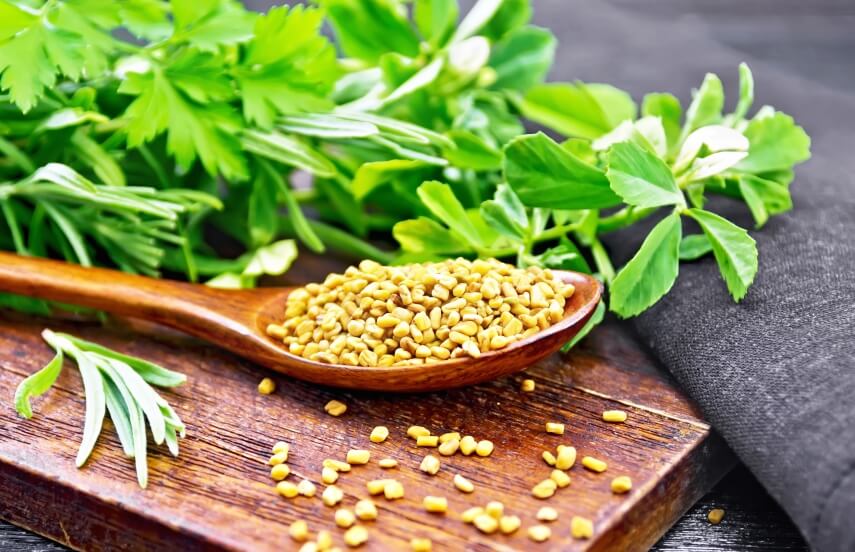
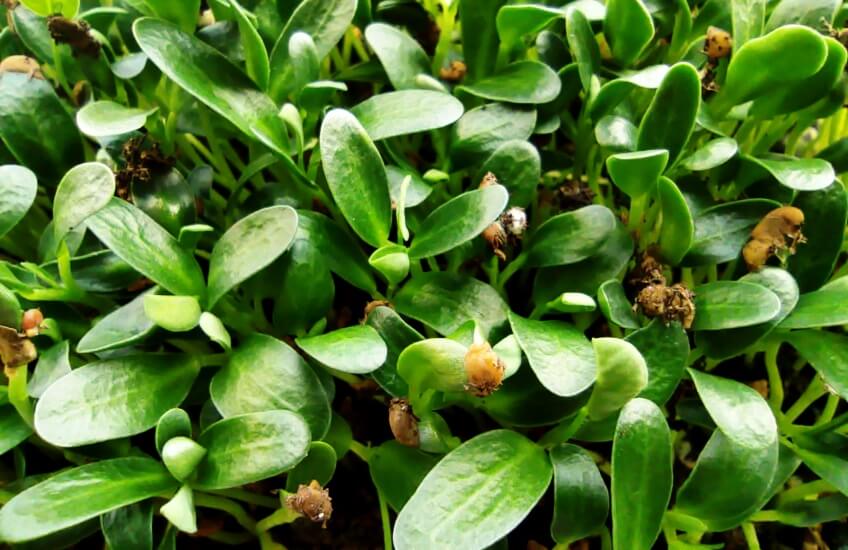
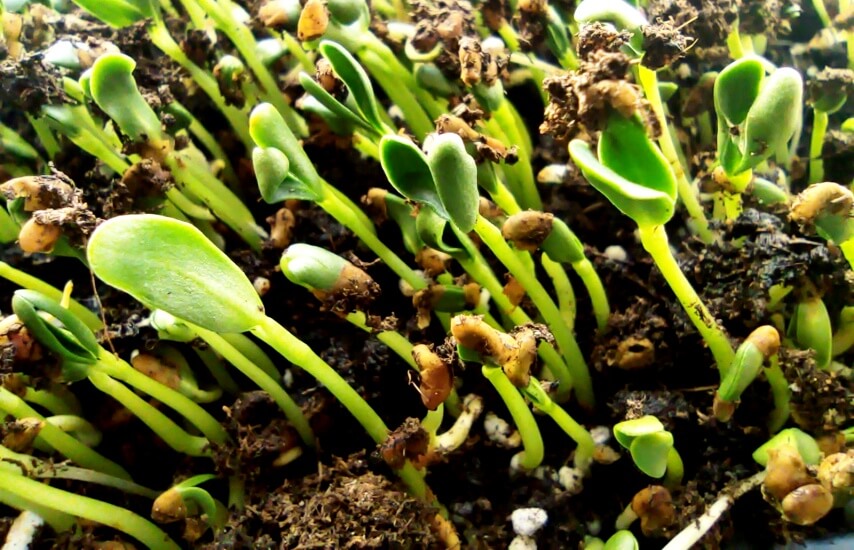

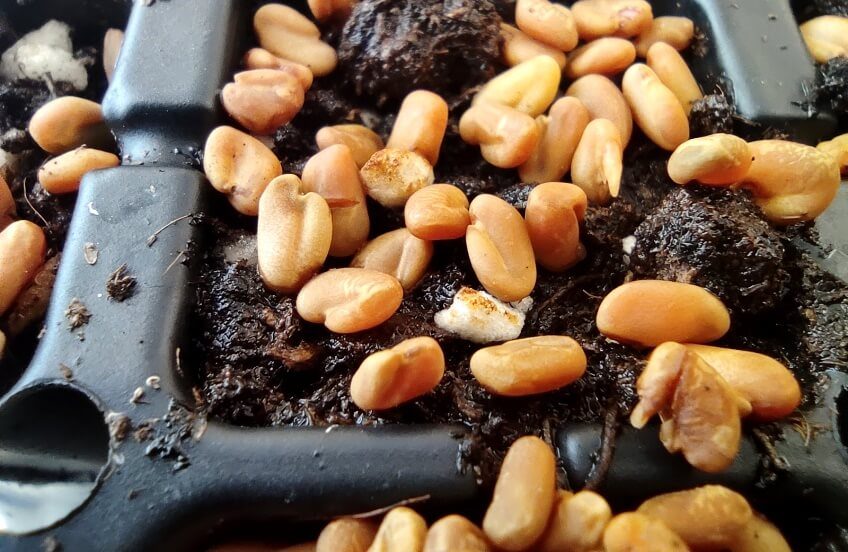
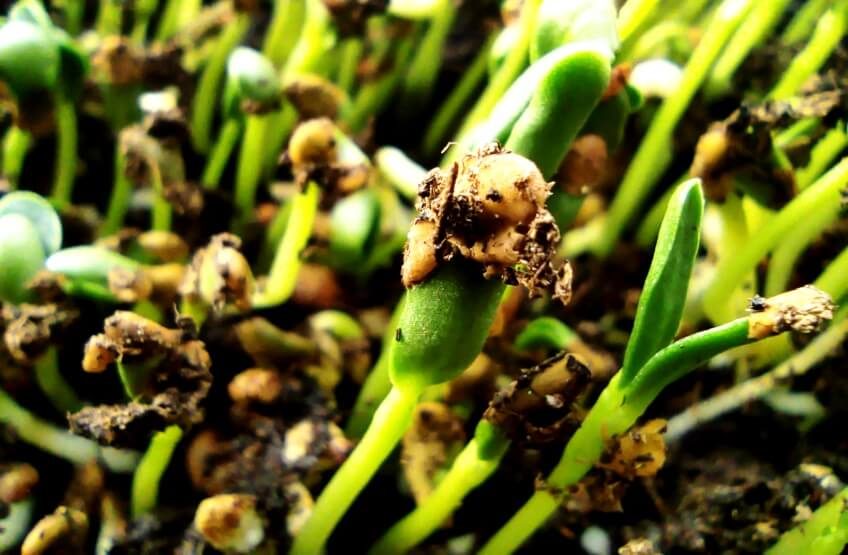



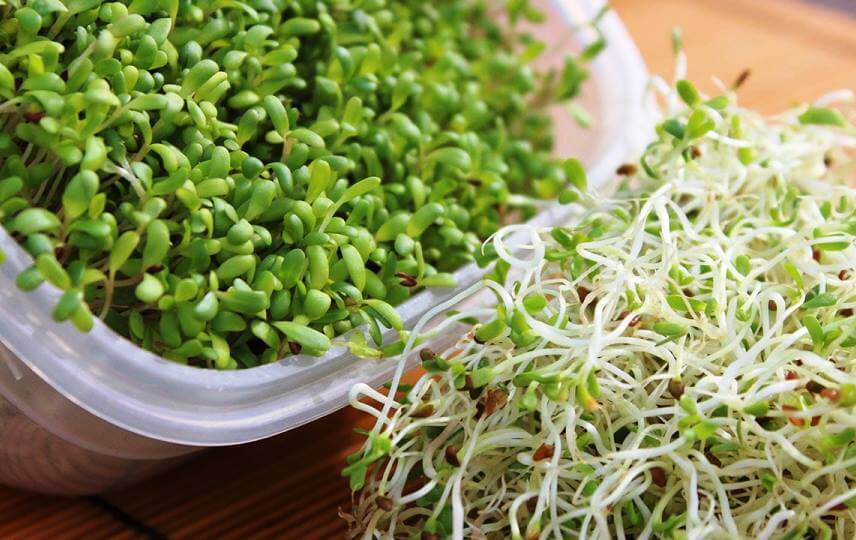

I used Fenugreek microgreen seeds combined with daikons, alfalfa microgreens, sprouts, and a little arugula, to make a delicious side dish to go with buttery fried cod that wasn’t breaded. The proper amount of fenugreek was added.